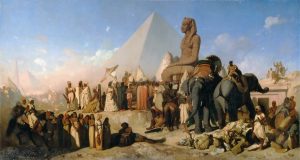Cyrus the Great was the Persian king from the Achaemenid dynasty who ruled over the empire from 559–530 BC. He fell in love with the daughter of the Achaemenid Pharnaspes, Cassandane, who would become the ruler’s favorite wife. Cassandane, also known as Cassandana, was very attached to her husband, as there were rumors where she allegedly said she would rather die than leave Cyrus.
The couple gave birth to five children: their sons were Cambyses II and Bardiya, while their daughters were named Atossa, Artystone, and Roxane. Cyrus’ three most notable children were Cambyses II, Bardiya, and Atossa.
Roxane was rumored to have married Cambyses II, but this is a point of contention among historians who believe the ancient sources antagonized Cyrus’ successor. Meanwhile, Arytstone married Darius the Great, the third Anshan king.
Cambyses II
Cambyses II was his father’s successor; he ruled the Achaemenid empire from 530 to 522 BC; his rule lasted for seven years, and he was considered brief for a dynastic ruler. The early part of his career was spent as the governor of northern Babylonia, one of the empires his father conquered. His leadership was from April to December in the year of 538 BC. Then, from 530 BC onwards, he was Cyrus the Great’s co-ruler until his father’s death in a battle against the Massagetae tribe.
The successes of Cambyses II involved his expansion of the empire in northern Africa. He triumphed over Psamtik III, the pharaoh of Egypt. Continuing his conquests in Africa, Cambyses also took the city of Cyrenaica in Libya. However, his conquests were abandoned in 522 BC due to a revolt in Persia.
On his journey back to Syria, Cambyses II was wounded in his thigh; the injury developed gangrene, leading to his death three weeks later in Agbatana. With no offspring, Cambyses II’s younger brother named Bardiya rose to power.
Bardiya
Bardiya’s rule has conflicting accounts regarding who truly took to the throne. The Greek historian and “Father of History” Herodotus called him Smerdis or Smerdies, while another Greek historian, Ctesias, called Cyrus’ second son Tanyoxarces. Another Greek philosopher, military leader, and historian, Xenophon, called him Tanooxares. Meanwhile, the Latin writer referred to him as Mergis or Merdis. Lastly, the “Father of Tragedy,” Aeschylus, called him Merdis as well.
Ctesias wrote that while he was dying, Cyrus made Bardiya a satrap, the term for governor during that time. The younger Achaemenid brother then traveled to Egypt. From this point onward, Darius the Great and Herodotus have conflicting accounts.
Herodotus chronicled in two of his intricately written accounts of the Achaemenid empire that Cambyses was envious of his younger brother’s competence in battle, thus sending him far from himself– to the city of Susa in the Zagros mountains. He then had Bardiya murdered by one of his counselors named Prexaspes.
Conversely, Darius the Great’s account in the Behistun inscription, a large rock holding his chronicles, expressed that Bardiya was killed by Cambyses and then impersonated by the magus named Gaumāta. Historians speculate that Darius wrote this to garner support for his rule, although he was not the son of Cyrus. Darius would eventually overthrow Bardiya, who he claimed was being impersonated.
Atossa
Cassandane and Cyrus’ first daughter, Atossa, was born in 550 BC. Herodotus wrote that she married her brother Cambyses which could have been considered illegal or taboo during the time. However, the Classical scholar Dr. Maria Brosius mentioned that the sources claiming Cambyses was incestuous were found to be highly critical of the Achaemenid ruler, which could be interpreted as bias.
During Darius the Great’s rule, he married Atossa and gave birth to his successor, Xerxes I, continuing the Achaemenid line. She was still alive when Xerxes marched on Greece in 480 BC.
